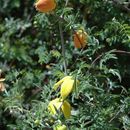Cyclicity
(
Anglèis
)
fornì da Plants of Tibet
Flowering from July to September.
Diagnostic Description
(
Anglèis
)
fornì da Plants of Tibet
Clematis ladakhiana is close relative of Clematis tangutica, but differs from the latter in its sepals more greenish-yellow (vs. lemon-yellow), densely pubescent inside and glabrous outside (vs. glabrous inside whilst being sparsely pubescent outside).
Distribution
(
Anglèis
)
fornì da Plants of Tibet
Clematis ladakhiana is occurring in Xizang of China, India.
Evolution
(
Anglèis
)
fornì da Plants of Tibet
Phylogenetic relationships within Clematis, including Naravelia, Archiclematis and Clematopsis, were analysed using nucleotide sequences of chloroplast DNA sequences matK and trnK introns, atpB-rbcL spacer, rpoB-trnC spacer, psbA-trnH-trnQ spacer, rbcL-accD spacer and the nuclear ITS regions (Miikeda et al., 2006). The phylogenetic trees resulting from these analyses suggested nine major clades. The genera Archiclematis, Naravelia and Clematopsis were found to be nested within the genus Clematis, and should be included within it. Within the genus Clematis, the traditional subgenus Viorna was found to be monophyletic. The remaining subgenera (Flammula, Clematis and Campanella) and sections Flammula, Clematis and Cheiropsis, however, were found to be paraphyletic or polyphyletic. Enormous morphological diversification and very few nucleotide substitutions within Clematis indicate the recent radiation of the genus.
General Description
(
Anglèis
)
fornì da Plants of Tibet
Clambering or sprawling shrub with stems up to 2-3 m long, slightly pubescent to glabrous, often tinged with purplish-brown. Leaves pinnate with 5-7 leaflets or more or less bipinnate; leaflets rather glaucous-green, narrow-lanceolate, 2.7-9 cm long, 0.4-2 cm wide, entire or with 1-2 lobes in the lower part, caudate, acute, glabrous or subglabrous above and beneath. Flowers axillary, rarely terminal, in groups of 3-5, sometimes solitary, yellow or orange-yellow, often tinged or spotted with purplish-brown or reddish-brown on the exterior, the sepals generally spreading rather widely apart, the filaments reddish-purple. Peduncle 0.6-4.7 cm long. Bracts similar to the leaves though smaller and generally with only 3-5 leaflets. Pedicels 1.5-12 cm long, slender, sparsely pubescent to subglabrous, generally more densely pubescent when young. Sepals narrow-lanceolate to elliptic, 15-25 mm long, 4-10 mm wide, acute to acuminate, glabrous or subglabrous on the exterior, except along the margin, generally densely pubescent on the interior. Filaments 6-10 mm long; anthers 2-3 mm long. Styles up to 40 mm long in fruit.
Habitat
(
Anglèis
)
fornì da Plants of Tibet
Growing in hedges and bushes, or scrambling amongst rocks along river valleys; 2800-3850 m.
Morphology
(
Anglèis
)
fornì da Plants of Tibet
Clematis ladakhiana is here defined to leaflets rather narrow and long-acuminate, generally with several acute lobes or teeth in the lower half.

